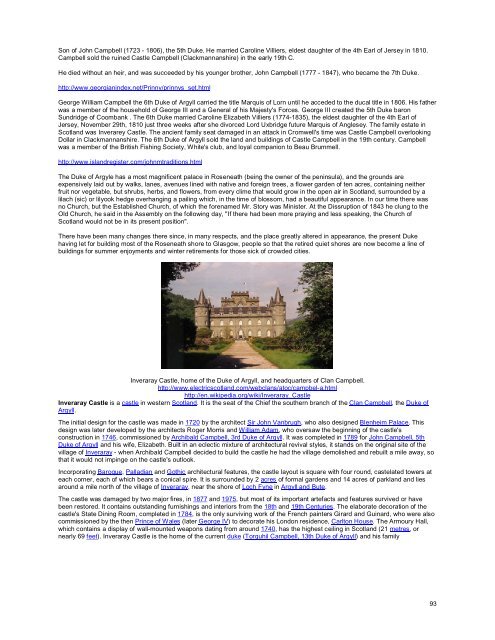Grand Masters of Scotland - Onondaga and Oswego Masonic ...
Grand Masters of Scotland - Onondaga and Oswego Masonic ...
Grand Masters of Scotland - Onondaga and Oswego Masonic ...
You also want an ePaper? Increase the reach of your titles
YUMPU automatically turns print PDFs into web optimized ePapers that Google loves.
Son <strong>of</strong> John Campbell (1723 - 1806), the 5th Duke. He married Caroline Villiers, eldest daughter <strong>of</strong> the 4th Earl <strong>of</strong> Jersey in 1810.<br />
Campbell sold the ruined Castle Campbell (Clackmannanshire) in the early 19th C.<br />
He died without an heir, <strong>and</strong> was succeeded by his younger brother, John Campbell (1777 - 1847), who became the 7th Duke.<br />
http://www.georgianindex.net/Prinny/prinnys_set.html<br />
George William Campbell the 6th Duke <strong>of</strong> Argyll carried the title Marquis <strong>of</strong> Lorn until he acceded to the ducal title in 1806. His father<br />
was a member <strong>of</strong> the household <strong>of</strong> George III <strong>and</strong> a General <strong>of</strong> his Majesty's Forces. George III created the 5th Duke baron<br />
Sundridge <strong>of</strong> Coombank . The 6th Duke married Caroline Elizabeth Villiers (1774-1835), the eldest daughter <strong>of</strong> the 4th Earl <strong>of</strong><br />
Jersey, November 29th, 1810 just three weeks after she divorced Lord Uxbridge future Marquis <strong>of</strong> Anglesey. The family estate in<br />
<strong>Scotl<strong>and</strong></strong> was Inverarey Castle. The ancient family seat damaged in an attack in Cromwell's time was Castle Campbell overlooking<br />
Dollar in Clackmannanshire. The 6th Duke <strong>of</strong> Argyll sold the l<strong>and</strong> <strong>and</strong> buildings <strong>of</strong> Castle Campbell in the 19th century. Campbell<br />
was a member <strong>of</strong> the British Fishing Society, White's club, <strong>and</strong> loyal companion to Beau Brummell.<br />
http://www.isl<strong>and</strong>register.com/johnmtraditions.html<br />
The Duke <strong>of</strong> Argyle has a most magnificent palace in Roseneath (being the owner <strong>of</strong> the peninsula), <strong>and</strong> the grounds are<br />
expensively laid out by walks, lanes, avenues lined with native <strong>and</strong> foreign trees, a flower garden <strong>of</strong> ten acres, containing neither<br />
fruit nor vegetable, but shrubs, herbs, <strong>and</strong> flowers, from every clime that would grow in the open air in <strong>Scotl<strong>and</strong></strong>, surrounded by a<br />
lilach (sic) or lilyook hedge overhanging a pailing which, in the time <strong>of</strong> blossom, had a beautiful appearance. In our time there was<br />
no Church, but the Established Church, <strong>of</strong> which the forenamed Mr. Story was Minister. At the Dissruption <strong>of</strong> 1843 he clung to the<br />
Old Church, he said in the Assembly on the following day, "If there had been more praying <strong>and</strong> less speaking, the Church <strong>of</strong><br />
<strong>Scotl<strong>and</strong></strong> would not be in its present position".<br />
There have been many changes there since, in many respects, <strong>and</strong> the place greatly altered in appearance, the present Duke<br />
having let for building most <strong>of</strong> the Roseneath shore to Glasgow, people so that the retired quiet shores are now become a line <strong>of</strong><br />
buildings for summer enjoyments <strong>and</strong> winter retirements for those sick <strong>of</strong> crowded cities.<br />
Inveraray Castle, home <strong>of</strong> the Duke <strong>of</strong> Argyll, <strong>and</strong> headquarters <strong>of</strong> Clan Campbell.<br />
http://www.electricscotl<strong>and</strong>.com/webclans/atoc/campbel-a.html<br />
http://en.wikipedia.org/wiki/Inveraray_Castle<br />
Inveraray Castle is a castle in western <strong>Scotl<strong>and</strong></strong>. It is the seat <strong>of</strong> the Chief the southern branch <strong>of</strong> the Clan Campbell, the Duke <strong>of</strong><br />
Argyll.<br />
The initial design for the castle was made in 1720 by the architect Sir John Vanbrugh, who also designed Blenheim Palace. This<br />
design was later developed by the architects Roger Morris <strong>and</strong> William Adam, who oversaw the beginning <strong>of</strong> the castle's<br />
construction in 1746, commissioned by Archibald Campbell, 3rd Duke <strong>of</strong> Argyll. It was completed in 1789 for John Campbell, 5th<br />
Duke <strong>of</strong> Argyll <strong>and</strong> his wife, Elizabeth. Built in an eclectic mixture <strong>of</strong> architectural revival styles, it st<strong>and</strong>s on the original site <strong>of</strong> the<br />
village <strong>of</strong> Inveraray - when Archibald Campbell decided to build the castle he had the village demolished <strong>and</strong> rebuilt a mile away, so<br />
that it would not impinge on the castle's outlook.<br />
Incorporating Baroque, Palladian <strong>and</strong> Gothic architectural features, the castle layout is square with four round, castelated towers at<br />
each corner, each <strong>of</strong> which bears a conical spire. It is surrounded by 2 acres <strong>of</strong> formal gardens <strong>and</strong> 14 acres <strong>of</strong> parkl<strong>and</strong> <strong>and</strong> lies<br />
around a mile north <strong>of</strong> the village <strong>of</strong> Inveraray, near the shore <strong>of</strong> Loch Fyne in Argyll <strong>and</strong> Bute.<br />
The castle was damaged by two major fires, in 1877 <strong>and</strong> 1975, but most <strong>of</strong> its important artefacts <strong>and</strong> features survived or have<br />
been restored. It contains outst<strong>and</strong>ing furnishings <strong>and</strong> interiors from the 18th <strong>and</strong> 19th Centuries. The elaborate decoration <strong>of</strong> the<br />
castle's State Dining Room, completed in 1784, is the only surviving work <strong>of</strong> the French painters Girard <strong>and</strong> Guinard, who were also<br />
commissioned by the then Prince <strong>of</strong> Wales (later George IV) to decorate his London residence, Carlton House. The Armoury Hall,<br />
which contains a display <strong>of</strong> wall-mounted weapons dating from around 1740, has the highest ceiling in <strong>Scotl<strong>and</strong></strong> (21 metres, or<br />
nearly 69 feet). Inveraray Castle is the home <strong>of</strong> the current duke (Torquhil Campbell, 13th Duke <strong>of</strong> Argyll) <strong>and</strong> his family<br />
93







![Richard [Nicholls] Harison / Harrison - Onondaga and Oswego ...](https://img.yumpu.com/24950065/1/190x245/richard-nicholls-harison-harrison-onondaga-and-oswego-.jpg?quality=85)
![Richard [Nicholls] Harison / Harrison - Onondaga and Oswego ...](https://img.yumpu.com/24950063/1/190x245/richard-nicholls-harison-harrison-onondaga-and-oswego-.jpg?quality=85)








